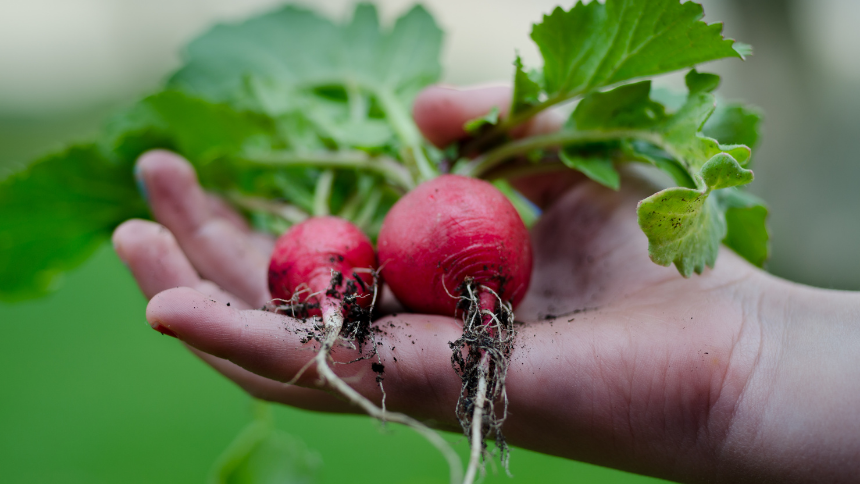
Australians waste an incredible 7.6 million tonnes of food each year. This isn’t just the food we throw out at home; it represents every stage of the food chain from crops not harvested to waste in food processing and manufacturing.
But we can all do something about it. Chefs keen to minimise waste embraced nose-to-tail cooking at the turn of the century (our grandmothers would argue they’ve been doing it at home for much longer). They started re-introducing diners to offal and other previously shunned cuts. It wasn’t just about sustainablity; there’s a lot of flavour and health benefits to be had, too.
The same applies to root-to-leaf cooking. Also known as root to shoot or root to stem, this sustainable approach to cooking uses an entire vegetable – leaves, stem and skins. It cuts waste, boosts nutrients and can help take the sting out of the weekly shopping bill.
Here are ideas to minimise your waste and maximise your health:
- Bought a beautiful bunch of beetroot? Don’t just lop the leaves and eat the root (the bright bulb). Sauté the leaves with slivers of garlic and serve with a fresh squeeze of lemon for a healthy side of greens, or use them (leaves and stems) as the basis for a brightly coloured pesto or dip.
- Don’t throw out those potato peelings! Spray them with oil then toss in salt, pepper and paprika, or other spices to your taste. Bake in a single layer at 200C for 10 to 15 minutes, or until crispy and serve as a pre-dinner snack. Parsnip and carrot peelings also crisp up well.
- In fact, why are you always peeling vegetables? Yes, they often still carry evidence they lived in the ground but they just need a good wash before cooking. There is usually more fibre on the skins of potatoes and plenty of vitamins and minerals, so don’t automatically reach for the peeler before you roast or steam them. Carrots, beetroot and sweet potato are also just as delicious roasted in their skins.
- If you must peel vegies, keep the scraps and freeze them. Once you have a couple of ziplock bags worth, you can make a simple stock with not much more than water, a bay leaf and some seasoning. They can also be added to soup for extra flavour – puree the soup and no-one will be any the wiser.
- Ever bought a bunch of celery and simply chopped off the leafy top part and thrown it in the bin? Celery leaves are highly nutritious and have a delicious, slightly aniseed taste. Try a celery leaf salad with ripe strawberries, crisp croutons, and a honey vinaigrette. They also make a nice herb, will enrich any stock and add extra punch to your healthy smoothie.
- The same goes for fennel fronds. If you’re throwing those delicate curly bits out, you really are missing out. Simply pull them off the stalks and use them in the same way you would other soft herbs like parsley or dill. They can also be added to stock, pesto and vinaigrettes for a delicate anise flavour, or used as a garnish on everything from eggs to salads.
- If you’re only using the coriander or parsley leaves when cooking a dish, give the stems a good rinse and finely chop them before packing into an ice cube tray. Cover with water and freeze ready to throw into your next soup, stew or curry for fresh flavour.
- Rather than breaking off the florets of your broccoli or cauliflower and throwing out the leaves and stalks, cut the head into slices instead and roast or steam them from top to bottom. If your recipe just calls for the florets, save the stems and sauté them with other vegies, such as kale or chard, and a little garlic and olive oil. Eat them as is or add to an omelette or frittata.
- Broccoli and cauliflower rice have become popular alternatives to traditional rice. Don’t just use the florets when you’re making it – the stalks can be whipped through your food processor in no time, too.
- Turnips don’t have the sexiest reputation but they have a lot more to offer than simply being relegated to soups and casseroles. Turnip greens – the stem and leafy part of the vegetable – are very nutritious and can be used raw in salads or smoothies, or to boost your morning omelette.
- If your vegies are starting to look a bit sad, don’t throw them out. Throw them in a pot instead, add some seasoning, water and make stock. This freezes well and means you’ll always have some handy for soups and other dishes.
- If you have an abundance of a particular type of veg, look for recipes that use it up without too much time or fuss, or you’ll end up throwing it out. Too much sweet potato or pumpkin? Make soup. A plethora of beetroot or carrot? Make a cake.
- Don’t forget about fruit, either. While the focus tends to be more on vegetables in root-to-leaf cooking, there are many ways to ensure fruit doesn’t end up in the bin, too. Use excess to make jams or smoothies, add to muffins or cakes, or create some icy treats.
- You can even keep your benches clean with waste! Place orange peels into a mason jar until full. When you have enough, add white vinegar until the peels are just covered and infuse for a minimum of two weeks in a dark place. Strain liquid through a fine-mesh sieve and add to a spray bottle to use as a multi-purpose cleaner.
Not only is root-to-leaf cooking great for the environment, but it’s also a budget-friendly way to enjoy more of the local food you love!